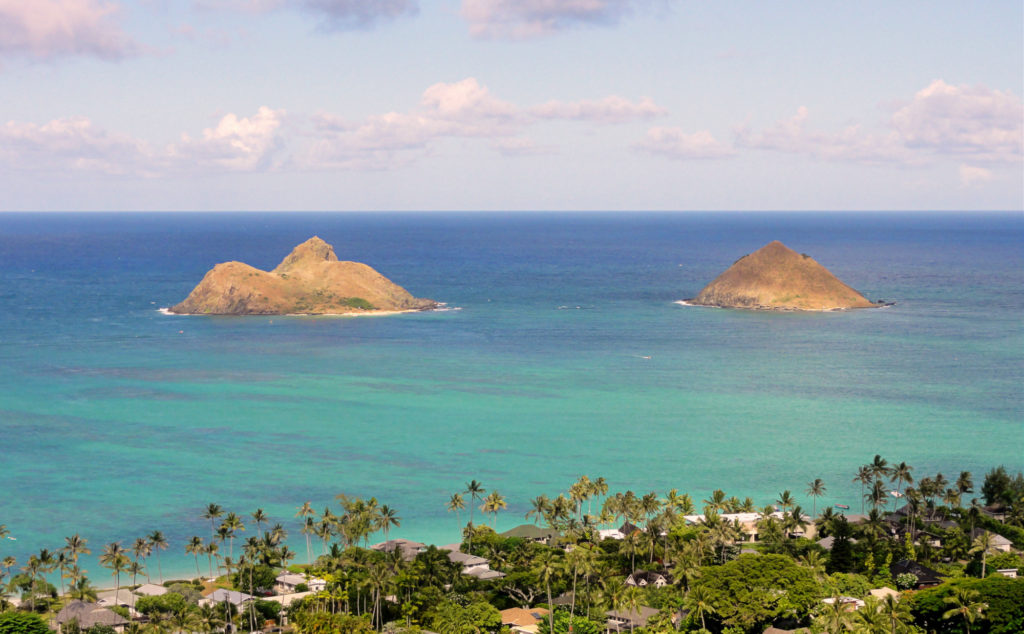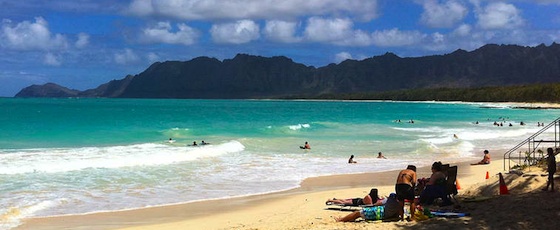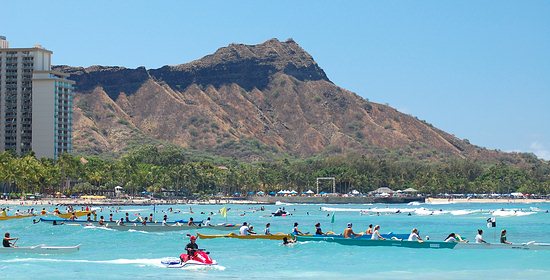Introduction
Oahu, one of the most visited islands in Hawaii, boasts a unique and diverse climate that ranges from lush rainforests to arid plains. Understanding Oahu’s climate zones is essential for appreciating its natural beauty and planning activities accordingly. This article delves into the various climate zones on Oahu, exploring their characteristics, impacts, and significance, along with practical tips for those considering living in Oahu or moving to Oahu.
Understanding Oahu’s Climate Zones
Oahu’s climate is influenced by its topography, trade winds, and ocean currents, resulting in distinct climate zones across the island. These zones vary in terms of temperature, rainfall, and wind patterns, each creating a unique environment. Recognizing these zones helps in understanding the island’s ecological diversity and planning for travel and outdoor activities.

The view from standing on top of the Pillboxes, an awesome blue picture!
Mokulua Islands, Oahu Hawaii by Cristo Vlahos is licensed under CC BY-SA 3.0. Image may have been resized or cropped from original.
Oahu’s Unique Climate Diversity
Compared to other Hawaiian islands, Oahu offers a remarkable diversity of climates within a relatively small area. While some areas receive ample rainfall, others remain dry throughout the year. This diversity is primarily due to the island’s varied topography and geographical features, which include mountains, valleys, and coastal plains.
Koolau Range and Windward Coast

“
View of the Koolau range from Ho’omaluhia Botanical Gardens, Kaneohe,
Hawaii, USA by Patricia Barden is licensed under CC BY-NC-ND 2.0. Image may have been resized or cropped from original. “
The Koolau Range, a prominent mountain range on Oahu, plays a crucial role in shaping the island’s climate. The Windward Coast, located on the eastern side of the island, receives significant rainfall due to the orographic effect, where moist trade winds ascend the mountains, cool down, and precipitate. This results in lush, green landscapes and vibrant ecosystems.
Leeward Coast Climate
In contrast to the Windward Coast, the Leeward Coast on the western side of Oahu experiences a drier climate. Sheltered from the trade winds by the Koolau Range, this area receives less rainfall and has more sunshine, making it ideal for beach activities and sunbathing.
Waianae Mountains Influence
The Waianae Mountains, located on the western side of Oahu, also influence the local climate. These mountains create a rain shadow effect, contributing to the arid conditions of the Leeward Coast. The area around the Waianae Mountains is characterized by dry, sunny weather and sparse vegetation.
North Shore Climate

Banzai Pipeline, North Shore, Ohau by Alan Grinberg is licensed under CC BY-NC-ND 2.0. Image may have been resized or cropped from original.
South Shore Climate

Fabulous day in Waikiki paradise!
Waikiki Postcard by nosha is licensed under CC BY-SA 2.0. Image may have been resized or cropped from original
The South Shore, home to the bustling city of Honolulu, enjoys a relatively mild climate. With moderate temperatures year-round and less rainfall compared to the Windward Coast, the South Shore is ideal for urban living and beach activities.
Central Oahu Climate
Central Oahu, nestled between the Koolau and Waianae mountain ranges, experiences a blend of climates. This area often has warmer temperatures and moderate rainfall, supporting a mix of agricultural activities and residential communities.
Microclimates of Oahu
Oahu’s varied topography gives rise to numerous microclimates. These localized climate zones can differ significantly from one another, even over short distances. For instance, a valley may have a different climate compared to a nearby ridge due to differences in elevation and exposure to wind and rain.
Rainfall Patterns
Rainfall on Oahu is highly variable, with some areas receiving over 200 inches of rain annually, while others get less than 20 inches. The Windward Coast and mountainous regions typically receive the most rain, while the Leeward side remains much drier. Understanding these patterns is essential for agriculture, water management, and planning outdoor activities.
Temperature Variations
Temperatures on Oahu are generally warm and consistent throughout the year, with slight variations between coastal and inland areas. Coastal regions tend to be cooler due to the moderating influence of the ocean, while inland and higher elevation areas can experience more significant temperature fluctuations.
Wind Patterns and Effects

Families relax at Bellows Beach on the northeast coast of Oahu near Kailua and the marine base, Kaneohe. Image Copyright CyberCom, Inc.
Trade winds are a dominant feature of Oahu’s climate, blowing from the northeast and bringing moist air to the island. These winds help to moderate temperatures and influence precipitation patterns. During periods of weakened trade winds, the island can experience hotter and more humid conditions, particularly on the Leeward side.
Impact of Altitude on Climate
Altitude significantly affects climate on Oahu, with higher elevations experiencing cooler temperatures and increased rainfall. The Koolau and Waianae mountain ranges create distinct climate zones based on altitude, supporting diverse ecosystems and influencing human activities such as agriculture and recreation.
Climate and Vegetation
Oahu’s climate zones support a wide range of vegetation types, from lush rainforests on the Windward side to dry, scrubby landscapes on the Leeward coast. Understanding the relationship between climate and vegetation is crucial for conservation efforts and managing natural resources effectively.
Human Impact on Climate
Human activities, including urbanization and agriculture, have significant impacts on Oahu’s climate zones. Urban areas tend to be warmer due to the heat island effect, while agricultural practices can alter local water cycles and vegetation patterns. Balancing development with environmental preservation is a key challenge for the island.
Seasonal Changes
Although Oahu’s climate is relatively stable year-round, there are noticeable seasonal changes. The island experiences a wetter winter season and a drier summer season. These seasonal variations affect everything from agriculture to tourism, making it important to understand the timing of activities and events.
Climate Change Effects
Climate change poses a significant threat to Oahu’s diverse climate zones. Rising temperatures, changing precipitation patterns, and sea level rise could dramatically alter the island’s ecosystems and human settlements. Proactive measures are needed to mitigate these impacts and protect Oahu’s natural and cultural heritage.
Living in Oahu: Practical Considerations
Living in Oahu offers a unique lifestyle, but it’s important to consider practical aspects such as housing, cost of living, and accessibility to amenities. Housing costs can be high, especially in popular areas like Honolulu. Additionally, the cost of goods and services is generally higher due to the island’s remote location.
Moving to Oahu: Tips and Advice
- Research Climate Zones: Understand the different climate zones to choose the best area for your lifestyle.
- Budget for Higher Costs: Prepare for higher living expenses, including housing and groceries.
- Embrace Local Culture: Engage with the local community and embrace the Hawaiian culture.
- Plan for Transportation: Consider the availability and convenience of public transportation or the need for a personal vehicle.
- Stay Informed: Keep up-to-date with local news and weather patterns to make informed decisions.
Conservation Efforts
Efforts to conserve Oahu’s climate zones are vital for preserving its natural beauty and biodiversity. Initiatives include protecting native vegetation, restoring ecosystems, and promoting sustainable land use practices. These efforts help to maintain the island’s ecological balance and ensure its resilience in the face of environmental changes.
FAQs
What are the main climate zones on Oahu? Oahu’s main climate zones include the Windward Coast, Leeward Coast, North Shore, South Shore, and Central Oahu, each with distinct characteristics influenced by topography and wind patterns.
Why is the Windward Coast of Oahu so lush? The Windward Coast receives significant rainfall due to the orographic effect, where moist trade winds ascend the Koolau Range, cool down, and precipitate, creating a lush, green landscape.
How does the Leeward Coast differ from the Windward Coast? The Leeward Coast is much drier and sunnier than the Windward Coast because it is sheltered from the trade winds by the Koolau Range, resulting in less rainfall.
What is the climate like on Oahu’s North Shore? The North Shore experiences a mix of wet winters and dry summers, with large waves during the winter months that attract surfers from around the world.
How do the Waianae Mountains affect Oahu’s climate? The Waianae Mountains create a rain shadow effect, contributing to the arid conditions on the Leeward Coast and influencing the local climate.
What impact does altitude have on Oahu’s climate? Altitude affects Oahu’s climate by creating cooler temperatures and increased rainfall at higher elevations, supporting diverse ecosystems and influencing human activities.
Conclusion
Oahu’s climate diversity is one of its most remarkable features, shaping the island’s environment, lifestyle, and appeal as a tourist destination. Understanding the various climate zones helps in appreciating Oahu’s natural beauty and planning activities accordingly. From the lush Windward Coast to the sunny Leeward side, Oahu’s climate zones offer something for everyone, highlighting the importance of preserving this unique ecological treasure.



What do you think?